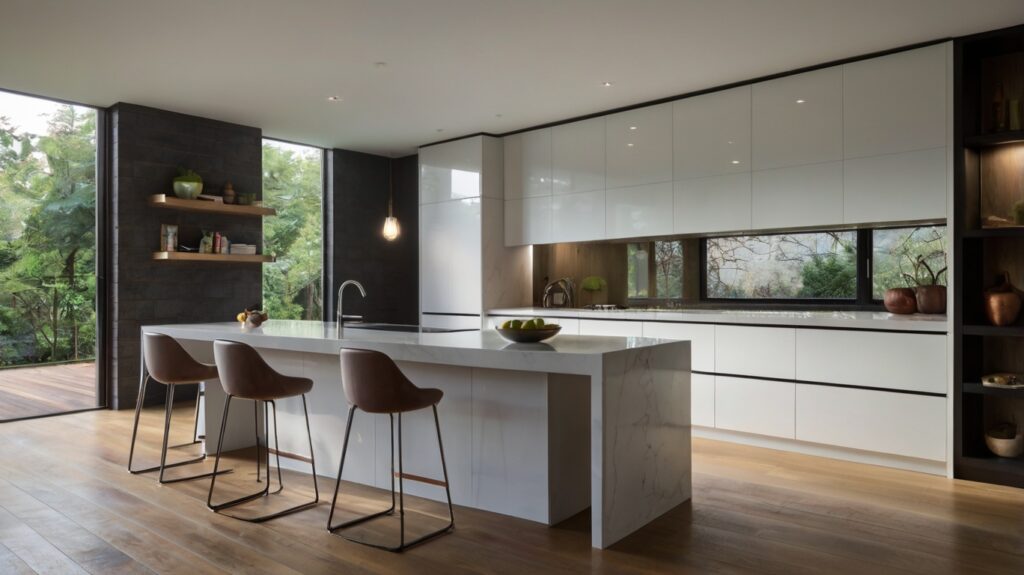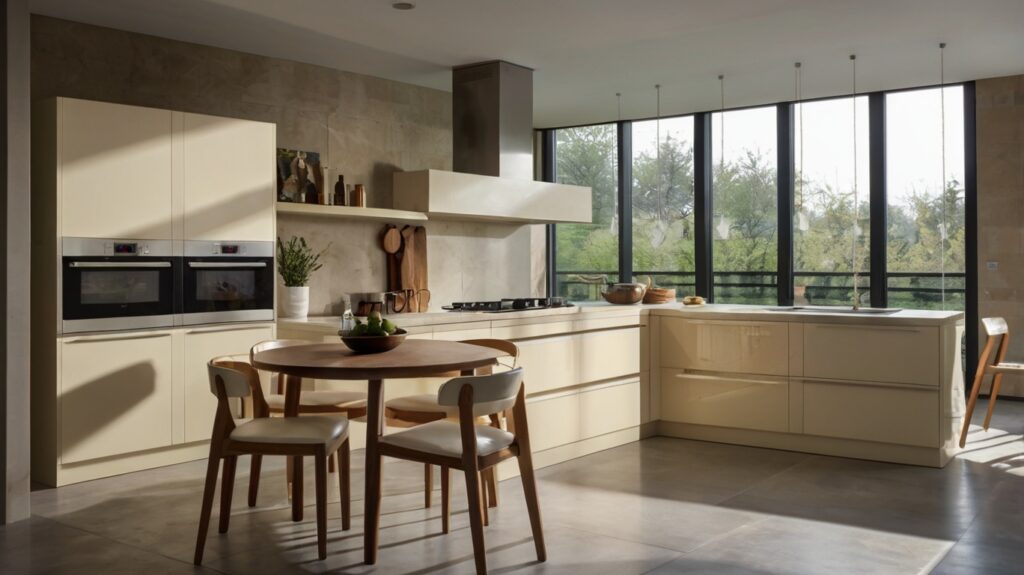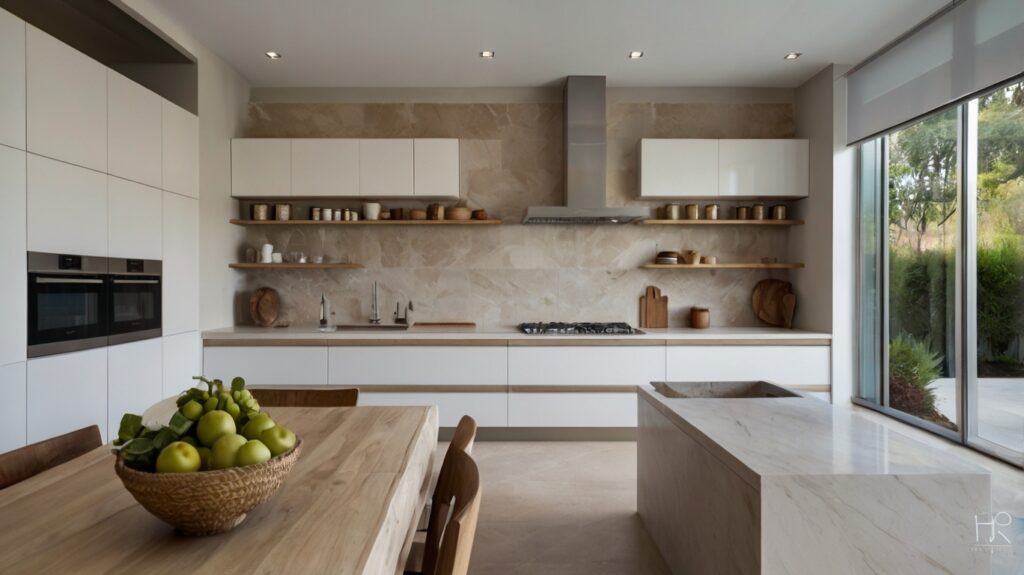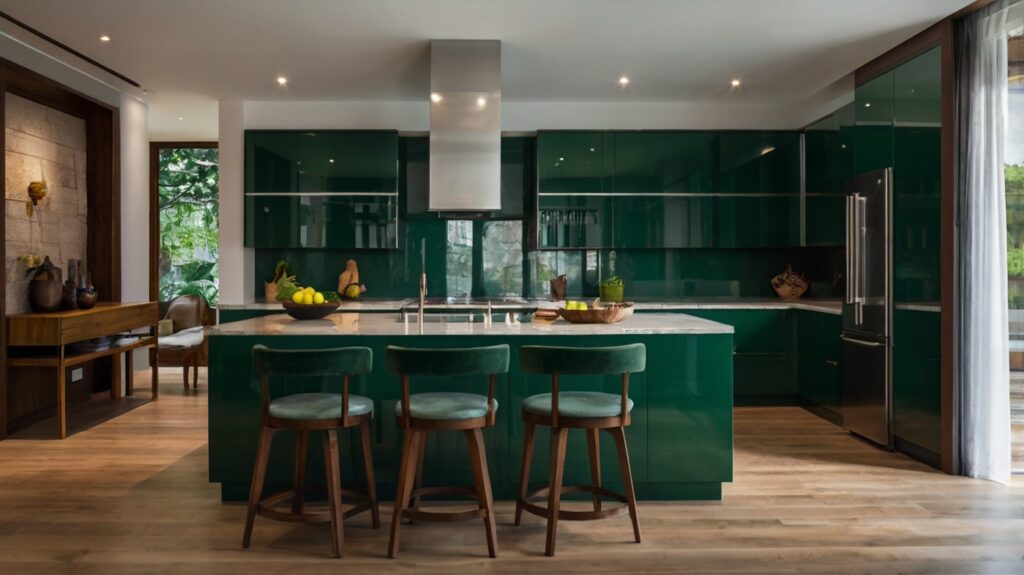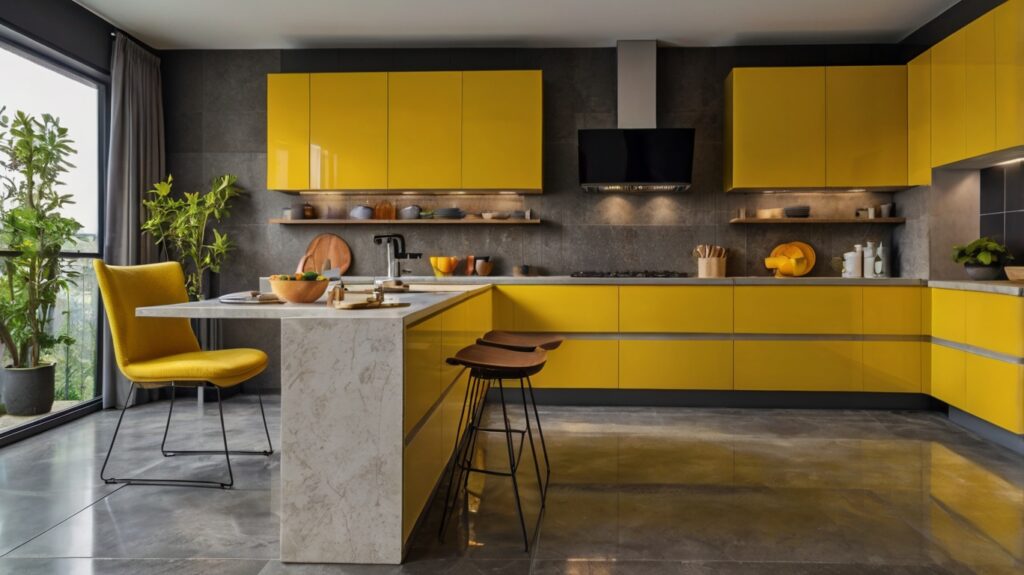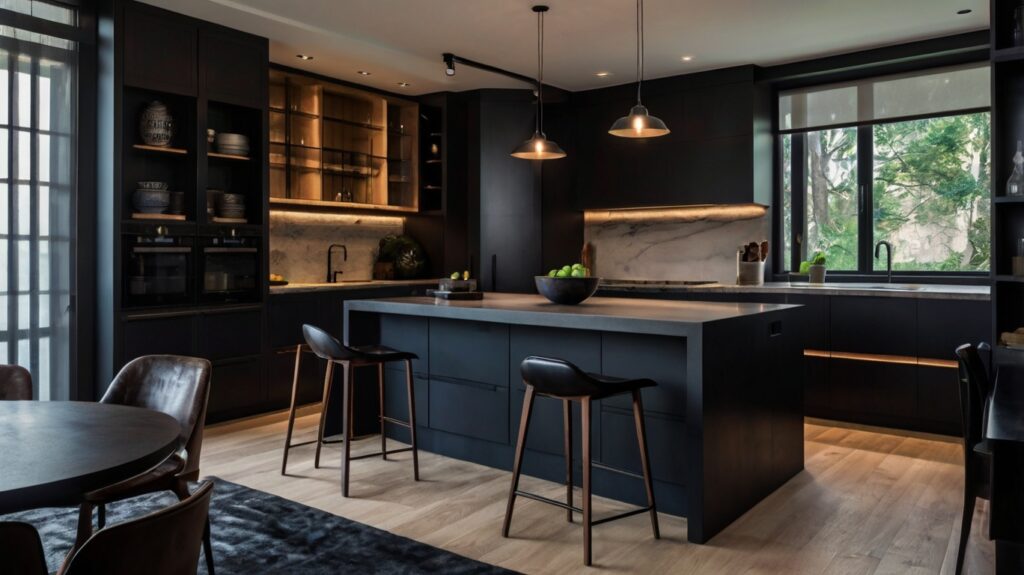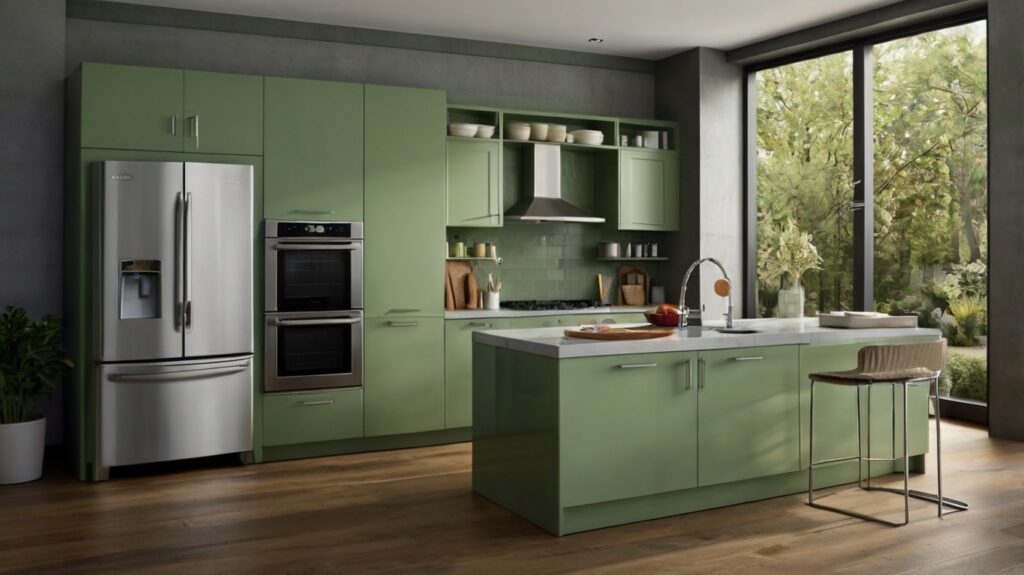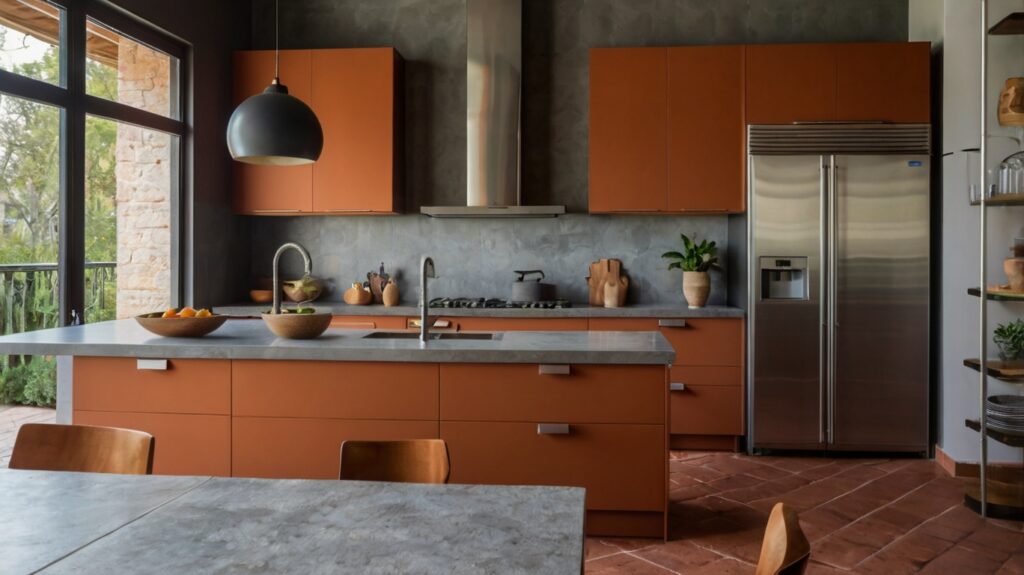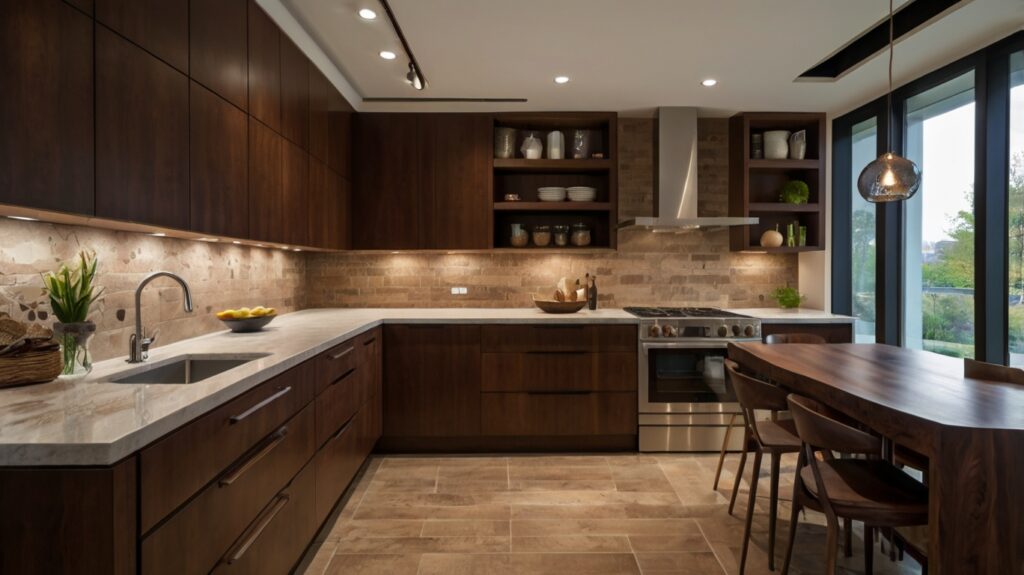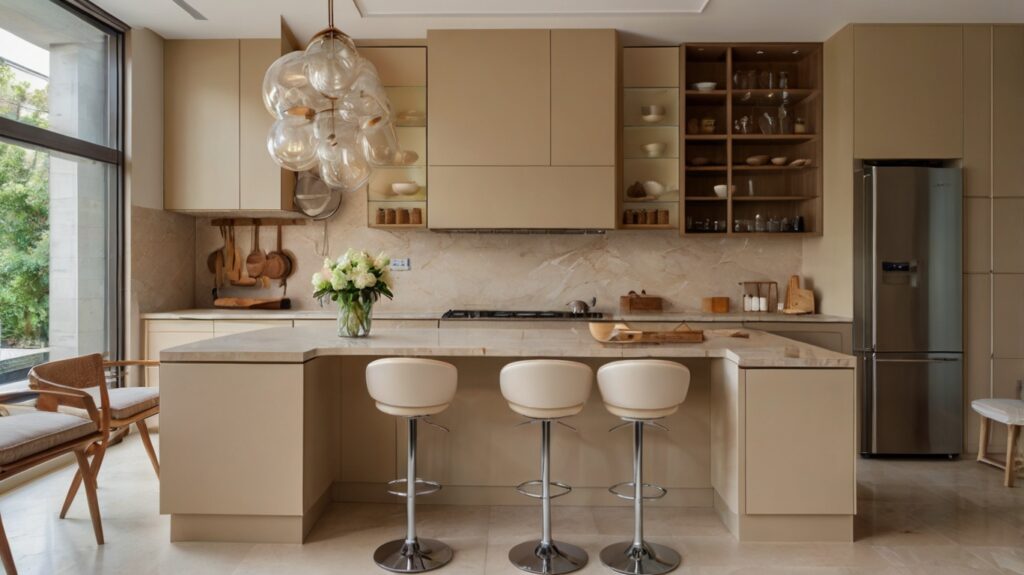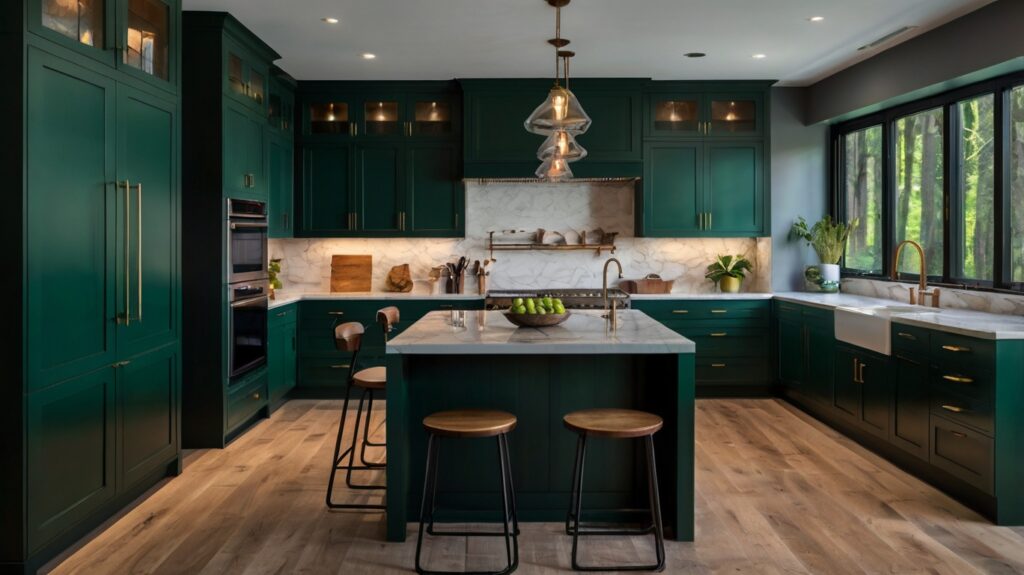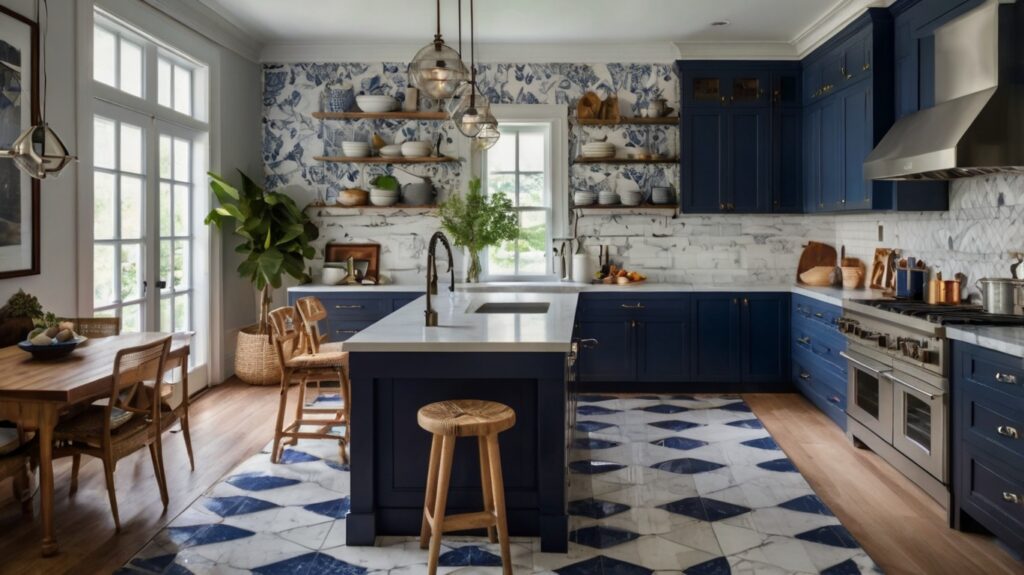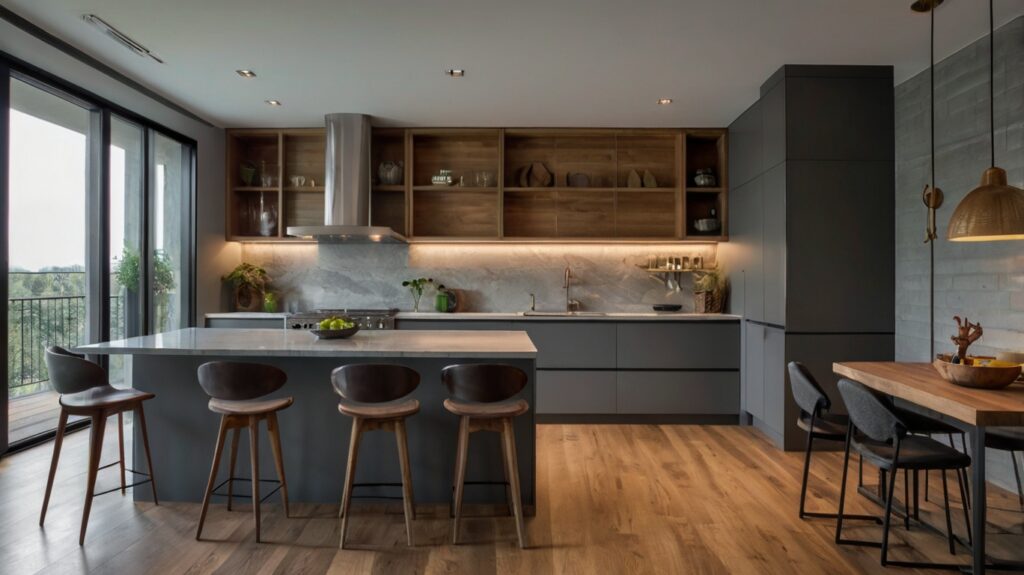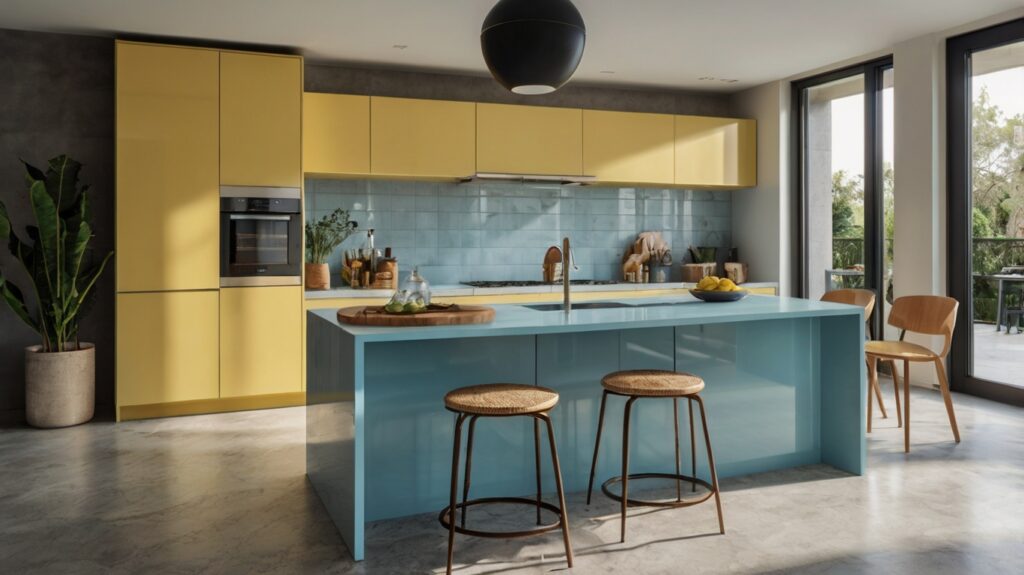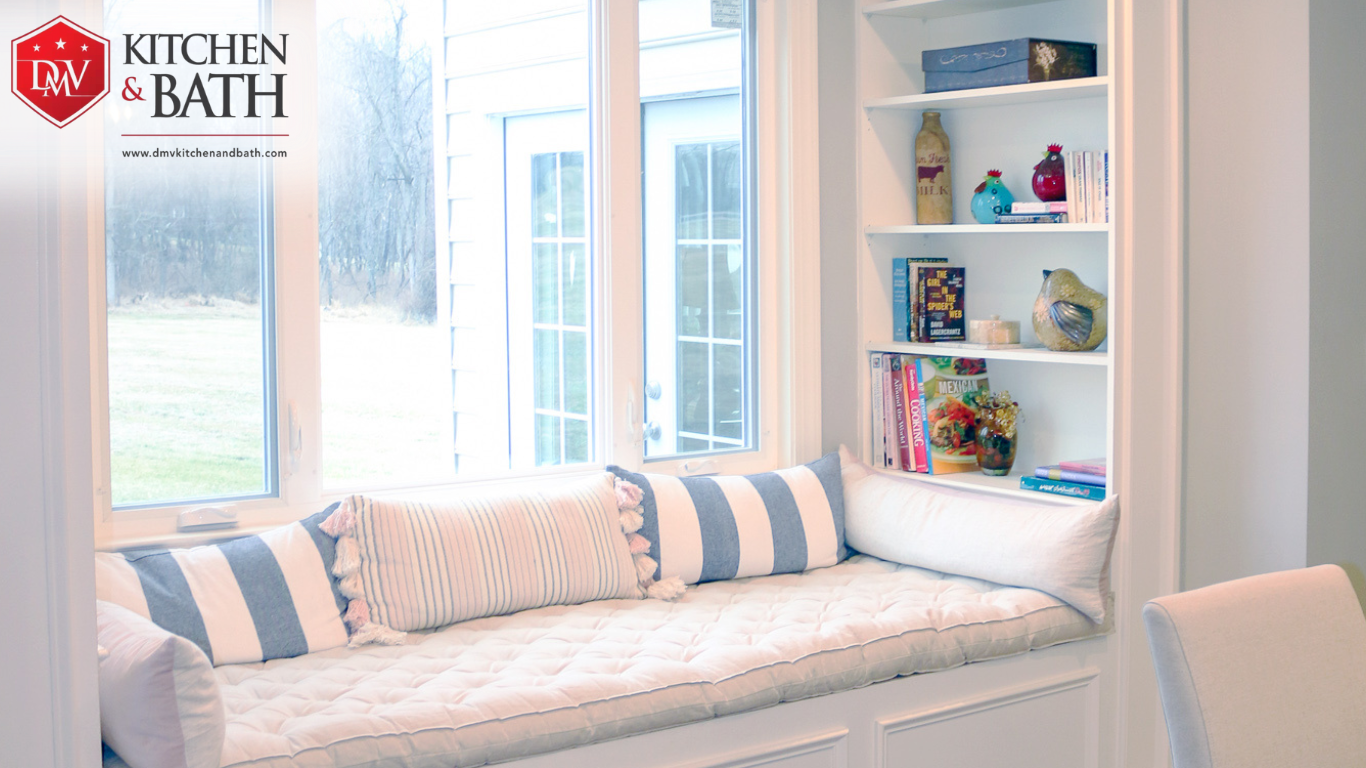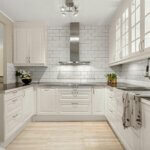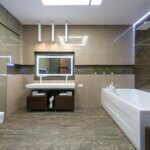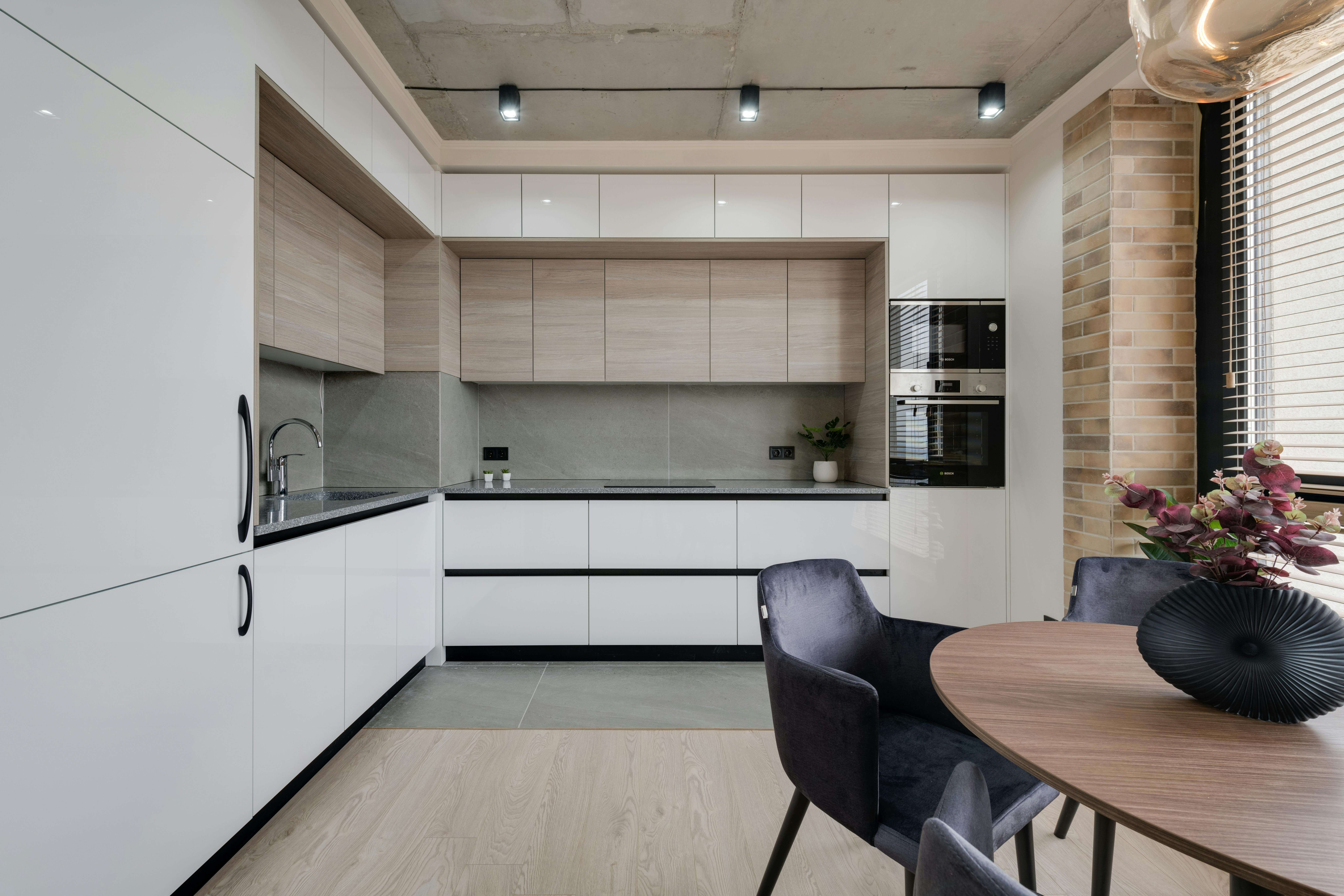
A Deep Dive into Modern Kitchen Color Schemes15 min read
In recent years, the design and aesthetics of modern kitchens have undergone a remarkable transformation. No longer just practical spaces for cooking, contemporary kitchens have evolved into the heart of the home, a place where functionality meets style, and where family and friends gather to share meals and create memories.
One of the most significant aspects of this transformation is the choice of colors. The palette of a kitchen can set the tone for the entire home, influencing the mood, atmosphere, and even the perceived space within this vital area.
The evolution of kitchen colors is a fascinating journey through trends, cultural influences, and technological advancements. In the past, kitchens were often confined to neutral tones, with whites and beiges dominating the scene.
These colors were chosen for their cleanliness and simplicity, providing a blank canvas prioritizing function over form. However, as interior design has become more adventurous and personalized, so too has the approach to kitchen colors.
Contents
The Power Of Kitchen Color Schemes
Today, modern kitchens boast a vibrant and diverse array of hues, from bold and daring shades to subtle and sophisticated tones. This shift reflects broader changes in how we view our living spaces.
Homeowners and designers are no longer afraid to experiment with colors that make a statement or reflect personal tastes. Interior designers play a crucial role in selecting the right color schemes to reflect personal tastes and enhance the overall look of the kitchen.
Color impacts our emotions and behaviors in subtle yet profound ways. In a kitchen, where we often start our day, prepare meals, and gather with loved ones, the color scheme can significantly affect the overall experience.
Bright, cheerful colors can energize and invigorate, perfect for morning routines. Soft, muted tones can create a relaxing and welcoming environment, ideal for winding down in the evening.
Modern Kitchen Color Schemes
When it comes to designing or remodeling a kitchen, color is one of the most transformative elements you can play with. Gone are the days when kitchens were merely utilitarian spaces hidden from guests.
Today, they are central hubs of activity and social interaction, and their design is a reflection of personal style, current trends, and practical needs. Color, in particular, has the power to set the mood, influence the perception of space, and create a cohesive aesthetic. The kitchen layout can also influence the choice of color schemes, ensuring that the design is both aesthetically pleasing and functional.
Classic Whites and Neutrals
White remains a perennial favorite in kitchen design, and it’s easy to see why. White cabinets are a popular choice for creating a clean and timeless look in the kitchen. A white kitchen exudes cleanliness, simplicity, and timelessness. It reflects light, making the space feel larger and more open—an excellent choice for smaller kitchens or those with limited natural light.
Moreover, a white palette provides a versatile backdrop that allows for easy updates with colorful accessories or seasonal decor changes.
Range of Shades
While pure white is a classic choice, various shades of white can add depth and warmth to a kitchen. Off-whites, creams, and ivories can soften the starkness of a pure white kitchen, making it feel more inviting and cozy. Light wood elements can also add warmth and modern appeal to a kitchen with white or neutral tones.
Neutrals like beige, taupe, gray, and greige (a blend of gray and beige) offer a soft and sophisticated look. These colors can create a calm and serene environment, perfect for a space where many begin and end their day. Neutrals are less likely to go out of style, providing a timeless quality that can endure changing trends.
Combining Whites and Neutrals
Layering Shades
Combining different shades of white and neutral tones can add dimension to your kitchen. Layering these colors can create a harmonious and sophisticated look. For instance, pairing white cabinetry with a light gray backsplash and taupe countertops can result in a balanced and elegant space. Additionally, incorporating a subway tile backsplash can add texture and visual interest when layering different shades of white and neutral tones.
Accents and Accessories
Introducing natural elements like wood, metal, and stone can enhance a white or neutral kitchen. Wooden floors or countertops can add warmth, while metal fixtures like brass or stainless steel can provide a modern touch. Stone elements, such as marble or quartz countertops, can add luxury and texture. Incorporating wood accents can create a soft modern feel and add a crisp touch to a white or neutral kitchen.
Transitional Design
A white and neutral color scheme is perfect for transitional kitchen designs, which blend traditional and contemporary elements. This approach allows for the inclusion of classic features, like shaker-style cabinets, alongside modern touches, such as sleek hardware and minimalist light fixtures.
Bold and Dramatic Hues
For those looking to make a statement, bold colors like deep blues, rich greens, and even black are becoming increasingly popular. These shades add depth and drama, creating a sophisticated and contemporary look. Incorporating vintage elements can create a timeless or retro feel in a kitchen with bold and dramatic hues.
A dark kitchen can be both striking and cozy, especially when paired with the right lighting and metallic accents. Think navy blue cabinets with brass hardware, or forest green islands with marble countertops.
Popular Bold Colors and Their Effects
Deep Blues
Navy blue and other deep blues are popular choices for modern kitchens. They exude a sense of luxury and sophistication while providing a calm, grounding effect.
Deep blues work well with metallic accents like gold or brass and can be paired with white or light countertops for a balanced look. Additionally, a white tile backsplash can create a clean and stunning contrast with deep blue cabinets or walls.
Rich Greens
Emerald, forest green, and olive are increasingly popular in kitchen design. These colors bring a touch of nature indoors, creating a fresh and organic feel.
Green pairs beautifully with natural wood elements and can be complemented with copper or bronze fixtures for an earthy, elegant look.
Bold Reds
Red is a powerful and energetic color that can stimulate appetite and conversation, making it an excellent choice for kitchens. Shades like cherry red, burgundy, and brick can add warmth and vibrancy.
Red works well as an accent color, whether on a feature wall, in appliances, or as part of a patterned backsplash.
Striking Yellows
Yellow is a bright, cheerful color that can bring a sense of sunshine and happiness to the kitchen. Mustard and ochre shades offer a more sophisticated take on yellow, adding warmth without overwhelming the space.
Yellow pairs well with neutral tones and can be used to highlight specific areas like a breakfast nook or island.
Dramatic Blacks
Black kitchens are the epitome of modern chic and sophistication. While it may seem unconventional, black can create a stunning and dramatic effect, especially when balanced with lighter elements and ample lighting.
Matte black finishes on cabinets and countertops provide a sleek, contemporary look, while glossy blacks add a touch of glamour.
Earthy and Natural Tones
The trend towards earthy and natural tones in kitchen design has gained significant momentum. These colors draw inspiration from nature, bringing warmth, tranquility, and a grounded feel to the heart of the home. A farmhouse sink can be a beautiful and functional addition to a kitchen with earthy and natural tones.
Earthy hues like terracotta, sage green, warm browns, and soft beige create an inviting and comforting environment, making the kitchen a serene sanctuary where cooking and socializing become a pleasure. Here’s a closer look at how to incorporate these natural tones into your kitchen.
Popular Earthy and Natural Tones
Sage Green
Sage green is a soft, muted green that brings a sense of calm and freshness to the kitchen. It pairs beautifully with natural wood elements, white countertops, and stainless steel appliances. Sage green can be used on cabinets, walls, or even as an accent color in decor items. Ample counter space is essential for meal preparation and functionality in a kitchen with sage green elements.
Terracotta
Terracotta, inspired by clay and earthenware, introduces a warm, rustic feel. This rich, reddish-brown color can add depth and character to the kitchen. Terracotta tiles, backsplashes, or even accent walls can bring a Mediterranean or southwestern vibe to the space.
Warm Browns
Warm browns, ranging from caramel to chocolate, add a sense of richness and comfort. These tones work well with wooden cabinetry, stone countertops, and metal accents. They can be used in flooring, furniture, and even kitchen accessories to create a cohesive look.
Soft Beiges and Creams
Soft beiges and creams offer a light, airy feel while maintaining warmth. These colors are perfect for creating a neutral backdrop that can be easily accessorized with other earthy tones. They work well on walls, cabinetry, and countertops, providing a clean and elegant look.
Deep Forest Green
Deep forest green is a bold yet natural choice that brings a touch of the outdoors inside. This color pairs wonderfully with brass or copper fixtures and can be used for cabinetry, islands, or even as a feature wall.
Creating a Cohesive Look
To achieve a cohesive look with earthy and natural tones, focus on creating harmony between colors, materials, and textures. Consistency in design elements, such as matching hardware finishes and coordinating textiles, can unify the space.
Additionally, maintaining a balance between light and dark tones will ensure that the kitchen feels inviting and well-proportioned.
Two-Tone and Contrasting Schemes
Two-tone and contrasting color schemes in kitchen design have become increasingly popular as homeowners seek to create visually dynamic and personalized spaces. This approach involves using two distinct colors to highlight different areas or elements within the kitchen, adding depth, interest, and a modern touch. Choosing the right bar stools in different styles, colors, and materials can complement and enhance the overall look of a two-tone or contrasting kitchen.
Popular Two-Tone and Contrasting Combinations
Classic Black and White
A timeless and elegant choice, black and white kitchens exude sophistication and modernity. White upper cabinets paired with black lower cabinets or a black island can create a striking and balanced look. This combination also allows for flexibility in adding accent colors through decor and accessories.
Navy and White with Blue Cabinets
Navy and white is a chic and contemporary combination that adds a touch of nautical charm. Navy lower cabinets contrasted with white upper cabinets can make a kitchen feel fresh and vibrant. This pairing works well with brass or gold hardware for a luxurious finish.
Gray and Wood
Combining gray tones with natural wood creates a warm and modern aesthetic. Gray cabinets or walls can be softened with wooden countertops, shelves, or flooring. This combination brings a touch of nature into the kitchen, creating a balanced and inviting space.
Green and Gold
Deep green paired with gold accents can create a luxurious and sophisticated look. Forest green cabinets or an island contrasted with gold hardware and light fixtures can add a touch of elegance and richness to the kitchen.
Blue and Yellow
For a more playful and vibrant look, consider a combination of blue and yellow. A blue island or lower cabinets paired with soft yellow walls or backsplashes can create a cheerful and welcoming atmosphere.
Examples of Two-Tone and Contrasting Modern Kitchen Color Schemes
Upper and Lower Cabinets
A popular approach is mixing colors for upper and lower cabinets. It helps define the two levels and gives the kitchen a more organized, structured vibe.
Plus, it’s a simple way to add personality and visual interest without overwhelming the space.
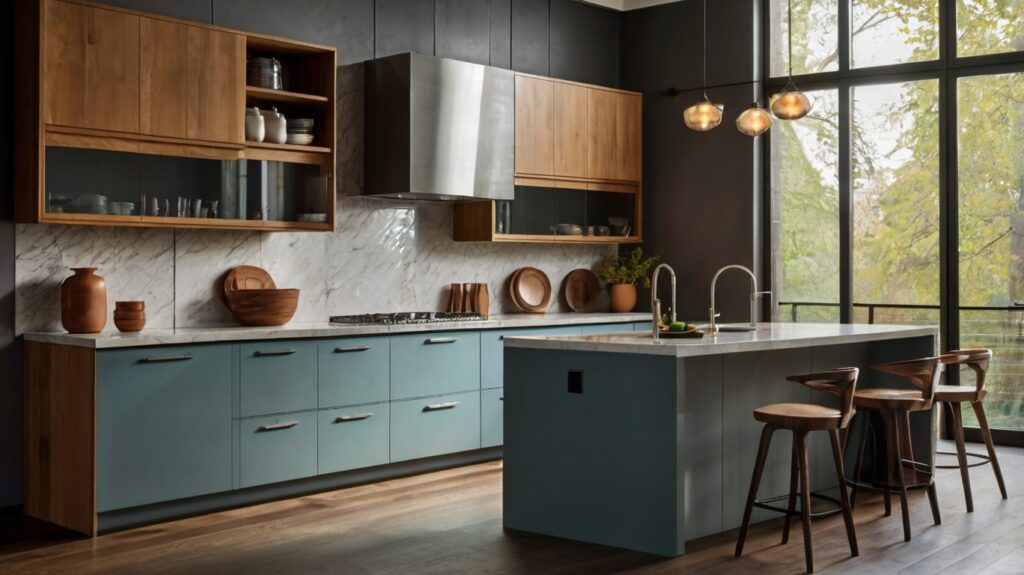
Stainless Steel Appliances and Fixtures
You can also play with contrasting colors on appliances and fixtures. Think of a bold red fridge or a blue range standing out against neutral cabinets—it’s a fun way to add a pop of color and show off some personality!
Plus, it turns everyday items into stylish focal points.
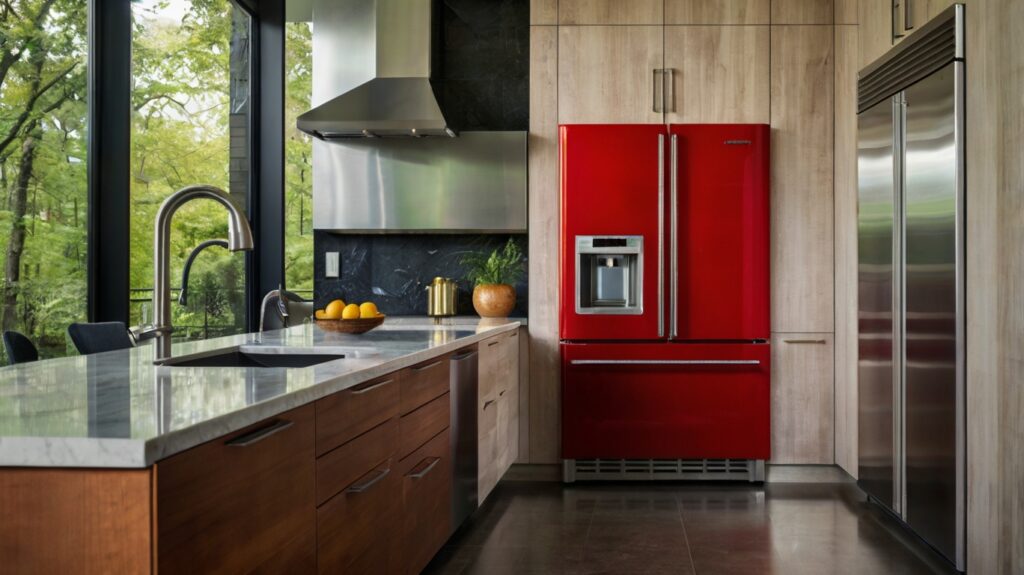
Accent Walls and Subway Tile Backsplashes
Using a bold color for an accent wall or backsplash can create a striking contrast with the rest of the kitchen. This method is particularly effective in highlighting specific areas such as the cooking zone or a breakfast nook.
An open-concept kitchen layout can seamlessly integrate the dining room, creating a cohesive and functional space for cooking and entertaining.
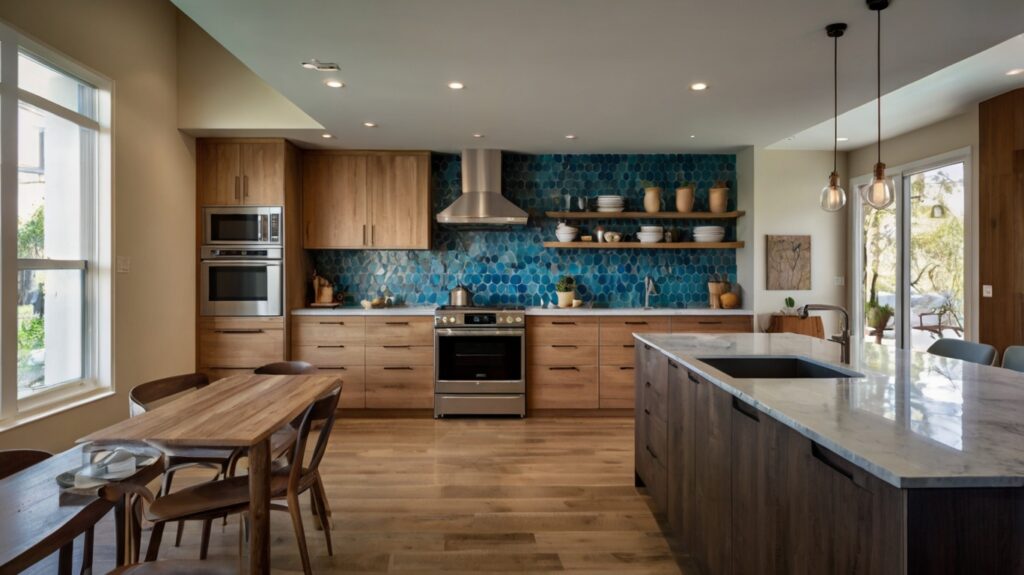
Island Contrasts
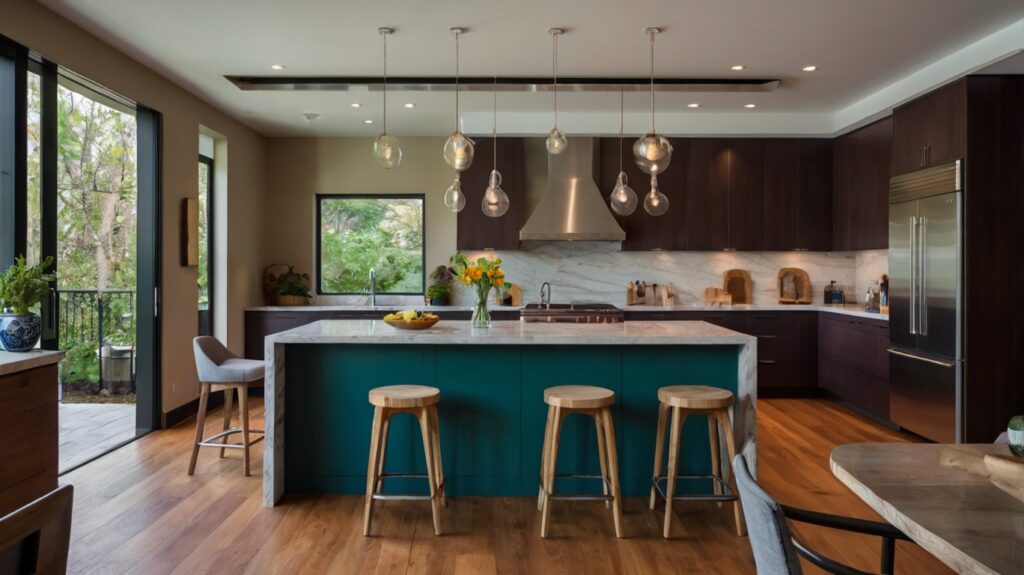
Final Thoughts
Ultimately, the best kitchen color schemes for your culinary space is one that reflects your taste and lifestyle. It’s about creating a space where you feel comfortable and inspired, whether that’s a serene, all-white kitchen, a bold, darkly-hued cooking space, or a cozy, earthy retreat. Modern kitchen color schemes offer endless possibilities, allowing you to craft a kitchen that is uniquely yours—a blend of style, function, and personal expression.
As we continue to embrace these trends, the modern kitchen remains a testament to the ever-evolving nature of home design, blending tradition with innovation in a harmonious symphony of colors.
Ready to transform your kitchen into a stunning, modern space?
Discover the perfect color scheme that reflects your style and enhances your home. Contact us today to schedule a consultation with our designers or get a free kitchen and bathroom remodeling estimate. Your dream kitchen is just a call away!





